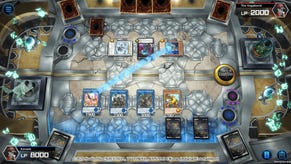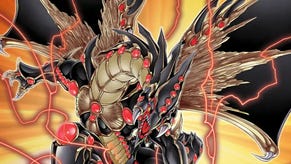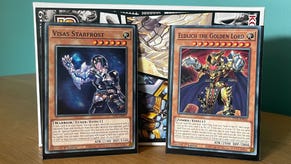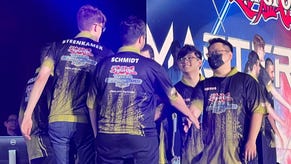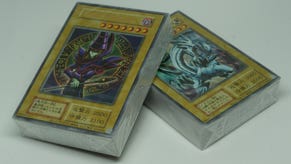On Japan’s biggest stage, Yu-Gi-Oh!’s 25th anniversary event celebrated its past by looking to the future
Hesitancy to delve too deeply into the making of the hit series and its card game couldn’t stop The Legend of Duelist Quarter Century from being a meaningful tribute to its creators and community.
On February 4th 1999, the Volume 1 booster pack for the Yu-Gi-Oh! Official Card Game was released in stores across Japan to massive commercial success. At long last, the beloved card game seen in Kazuki Takahashi’s manga and anime series had been successfully translated into the real-life trading card game we know today. To celebrate the 25th anniversary of this momentous occasion, a commemorative celebration was recently held in one of Japan’s biggest sports arenas, Tokyo Dome.
The decision to host The Legend of Duelist Quarter Century at this venue harkens back to the earliest years of the anime, a stage chosen as a way to close the book on one of the game’s darker chapters while celebrating its growth and looking to the future. In 1999, the success of Volume 1 of the TCG coinciding with new anime Yu-Gi-Oh! Duel Monsters kickstarted a phenomenon, demand for the game reaching unprecedented levels amongst audiences of all ages. Yu-Gi-Oh! fever was well and truly in the air. So, publisher Konami chose to mark the culmination of this unprecedented first year for the game with a major tournament. The stage? The very same Tokyo Dome.
It was a disaster. Issues on ticketing and crowd control coupled with the printing of exclusive promo cards for winners (headlined by what then would have been the only known copy of Blue-Eyes Ultimate Dragon) and an exclusive premium pack of new cards only to be sold at the show - including the final as-yet-unreleased piece of Exodia - the event was riddled with issues of overcrowding and violence which forced riot police to be called and the entire thing to be scrapped within hours.
The Legend of Duelist Quarter Century was a rematch for one of the more infamous moments in the series’ history. Safe to say, things were far more controlled this time round. That being said, it’s hard not to consider the legacy of the event as setting a template for the approach and tone of this 25-year celebration. This was a chance to face the past, close the book and set sights to the future. Wipe away the bad memories of the past, recognise the passion of fans and fire a starting gun for the next quarter-century.
When the Tokyo Dome celebrations were first announced during the finals of the World Championships last summer, the scale and significance of the event were somewhat lost in translation for English-speaking audiences. Many Japanese people use magnitudes of Tokyo Domes to refer to something large in scale; despite a smaller seating capacity of 55,000, the larger size of a baseball pitch makes this event the equivalent of throwing thousands of Yu-Gi-Oh! fans into Wembley Stadium for a weekend.
The Tokyo Dome event was the equivalent of throwing thousands of Yu-Gi-Oh! fans into Wembley Stadium for a weekend.
A typical Yu-Gi-Oh! Championship Series event or national tournament isn’t a fair comparison for what this event hoped to achieve, either. While there was a Battle City-inspired duel area at the event, The Legend of Duelist Quarter Century featured everything from two days of stage events starring anime voice actors and music stars - such as Oki Sojiro from Novelbright, JAM Project and Masami Okui - to tons of activities to pass away the hours for the many in attendance.
A diverse, orderly crowd of thousands descended on Tokyo Dome to celebrate the game they love, whether these were anime-only fans paying pilgrimage on behalf of their favourite characters, families or adults whose loyalty for the TCG has scarcely wavered over the past two decades. It was as though a community was coming home to roost, and the joy on the faces of fans was apparent even before many entered the venue. A large marquee poster outside the entrance of the stadium was almost invisible, crowded out by fans taking commemorative photos.
With camaraderie, community spirit and nostalgia wafting through the air, it was hard not to get emotional seeing such large numbers moving in unison to celebrate the thing they love. To manage crowds, events were split evenly between the stands and arena, with marked entry times for each. The stands were where special themed food was being sold to the lucky attendees able to snap up a bite before it sold out. Obelisk burgers washed down with Slifer Lemonade, Ra Hot Dogs topped off with Blue-Eyes or Red-Eyes dessert cups, these proved to be popular items across the weekend - and for good reason! While essentially rethemed baseball stadium food available on any matchday, biting down on a juicy teriyaki burger and getting a free sticker for your troubles was more than worth the asking price.
Dotted around the rest of the stands were more than enough activities to whittle away the hours. A special card wall proved a fascinating display piece of every card in TCG and Rush Duel history from the early days until now. It was almost humbling to spot one card in particular; one that might have blended into the noise towards the lower half of one of the middle display cases had it not been signed in bold, black biro. Holactie the Creator of Light was a Japan-only promo card from a Duel Art Campaign, and one of a small number of official cards drawn by none other than the late mangaka and series mastermind himself, Kazuki Takahashi.
It was hard not to get emotional seeing such large numbers moving in unison to celebrate the thing they love.
Speaking of the manga, two additional displays were focused on Takahashi’s original illustrations and story. In one, iconic panels recalling the complete story of the series were coloured and brought to life in time to the music of the series. In another, a 3D display made up of many of these panels was erected for a photo opportunity. A regular visitor in this area was none other than Kuriboh itself, the playful mascot always willing for a snap and a headbutt as he played with fans.
The arena was the home for a movie theatre, main stage, Battle City tournament area, trivia quiz and carnival games based on every era of the Yu-Gi-Oh! anime. The movie theatre chronicled the history of the rivalry between Yugi and Kaiba in animated form, all the way beyond the end of the original series to Dark Side of Dimensions. The carnival games, though simplistic, were a chance to play games inspired by the mechanics and characters of each series for a chance to win themed coasters for each protagonist; throw frisbees into the holes of the correct monsters to complete the Fusion Summon in Yu-Gi-Oh! GX, or reveal monsters to find the highest attack in a one-on-one duel against a fellow attendee.
For participating in any of these events, as well as the trivia quiz where you had to guess the voice actor or prove your knowledge of Yu-Gi-Oh! mechanics, players could receive a free participation promo card, more than ample encouragement. Anyone who wanted to sit back and relax would be entertained by the lineup of the stage show, where voice actors were paraded on stage to perform scripted duels and talented musicians performed their iconic theme songs to a ravenous crowd, while special guests would sit and discuss their love for the game or share stories of their experiences involved in creating elements of the series over the years.
The past was everywhere: on stage, in illustrations, in the movie theatre. Yet despite this, few of these experiences truly considered what it took to take the game from conception to reality. Guests on stage discussed their experiences watching the anime or playing the game, but beyond a few anecdotes from inside the recording booth from voice actors, rarely was there a discussion of how those moments came into existence.
The past was everywhere, but few of the experiences truly considered what it took to take the game from conception to reality.
Take the card wall, for example. In recent years, the popularity of certain monsters and archetypes has grown to rival that of the main characters themselves - evident in how Konami used the event as a launching pad for its own animation studio, unveiling a six-minute video bringing fan-favourite cards and archetypes to life. As the anime has shifted into becoming an introduction for younger fans to the game of Rush Duel in Japan, older fans have elevated archetypes like Sky Striker and Spirit Charmers to something just as recognisable and beloved as the anime characters of old. The new anime is proof of this.
With this in mind, is a new trailer for a business venture really celebrating these cards? A new anime, were it to come to fruition, would certainly be welcome for fans. But this was a convention of the series’ biggest fans, those who love the game and everything that goes into it. This could have been a rare occasion to lift the secretive veil on card design via an art gallery that showcased concept art for the creative process behind these cards, a rare chance to celebrate not just the game but the people who make it.
Any historical retrospective was rooted in future consumerism and the end product. The card wall was a cool timeline-of-sorts, but it only showed the end product and not the blood, sweat and tears that brought these cards to life. We could relive past highlights from the anime, but this again limited itself to reliving the past as we remember it without consideration of the work that went into making these moments so exciting and memorable in the first place.
I can’t help comparing this experience to how anime studio Toei celebrated 20 years of beloved magical-girl anime Pretty Cure, a similarly-influential cultural titan of a franchise in Japan. That occasion was marked with a touring museum that not only created displays of the toys and scenes that defined every era of the series to date, but offered a peek behind the curtain at concept art, animation cels and linework, original scripts, and a slew of behind-the-scenes material. Imagine if we could have seen the original sketches of the original Yu-Gi-Oh! manga in a special exhibition during The Legend of Duelist Quarter Century, or concept art for each era of the anime.
To experience the past, you had to pay extra for the privilege. As you would expect from any convention, exclusive goods only available to attendees were everywhere for dedicated fans to snap up. The first-ever starter deck in the series’ history, modelled on the decks of Seto Kaiba and Yugi Moto and the basis for the first starter decks to be released in English, was given an exclusive reprint in an exact replica of the set as it appeared on store shelves in 1999, complete with the third-generation, now-outdated but true-to-the-era rulebook. We couldn’t look at an exhibit noting the historical significance of the release, but we could buy it. Likewise, we had no gallery of concept art, but the special Quarter Century all-holo reprint of the Spirit Charmer structure deck included concept art for the charmers on its paper deck mat for those who paid for the privilege.
Opportunities for a gallery or timeline of past releases were replaced by a look towards the future. The team behind Master Duel held hourly presentations for an experimental AI framework within the digital game that would allow for anyone to create their own AI to duel against others, similar to a chess AI and more advanced than what has previously been possible with CPU opponents. The Duel Links team showcased a VR experiment that brought to life the entire duel arena and monsters from the series’ history inside virtual reality for the first time. While neither is confirmed for release and few attendees could even try the experience for themselves, it was a fascinating look towards how the game could evolve in the years to come.
Yu-Gi-Oh!’s 25th anniversary event was a celebration of the past with its eyes looking firmly towards the future.
The result was the same. Yu-Gi-Oh!’s 25th anniversary event was a celebration of the past with its eyes looking firmly towards the future. History was commercialised, whether in premium packs or starter decks that referenced the past - the premium pack replicates the packaging of the 1999 Tokyo Dome set - or in new planned releases. Booster packs with cards referencing the past, a collection of past video games to buy for your shiny new console.
While this may sound cynical, it’s a complaint that can only be made because the lack of true retrospective humility stands as the only glaring blind spot in what was an otherwise joyful and wonderful event to be a part of.
Konami truly succeeded in ensuring this experience was something to remember, with an unforgettable community spirit bursting from everyone in attendance. As I wandered the arena floor, I witnessed longtime friends reconnecting in the crowd below us. I saw adults and kids of all genders celebrating their favourite characters in cosplay, trading and duelling, and I never spotted a single person who wasn’t grinning from ear to ear.
Although the event’s lack of hindsight was notable, as a fan it’s also easy to understand why Konami would focus on the future when it has this much potential. Experiencing the realisation of a childhood dream as cards came to life before my eyes brought a tear to the inside of my VR headset, as did cheering and clapping along with a crowd of thousands at the unveiling of the Yu-Gi-Oh! Trading Card Game: The Chronicles animated movie.
My notes for improvement come not from a lack of enjoyment of the event but for a love of a franchise so strong I want to see it realise its full potential, alongside a selfish desire for more. Even with these complaints, as the second day came to an end and the sun had long since set, I found myself walking past the Tokyo Dome one last time, illuminated in the darkness with the crowd surrounding its popular poster long-since dispersed into the night. There, I stood, reminiscing not just on two days of fun but on 25 years of a series which has grown and changed with me. Who would have thought that the child that played Yu-Gi-Oh! in the school playground would end up here, I wondered, as I stared to the sky in emotional, contemplative awe at what I had experienced.
As I took one last photo outside the venue before heading home, I was approached by a fellow visitor. For a moment, we talked. He shared how he’d travelled from far outside Tokyo to attend, with plans to return home in the early hours of the following morning. We shared a few greetings, then parted ways into the night.
Two strangers, connected by a card game. That’s the power and long-lasting success of an event such as this, and a true showcase for 25 years of Yu-Gi-Oh!



